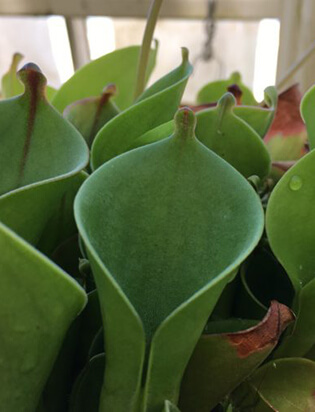Heliamphora


About Heliamphora
Common Name | Sun Pitchers
Family Name | Sarraceniaceae
Native to | Venezuela, Guyana, Brazil
Heliamphora is a genus of approximately 18 carnivorous plant species. Plants of this genus are endemic to Venezuela, Guyana, and Brazil. Most Heliamphora species are found growing on the Tepui mountains of the Guiana Highlands. The Tepuis are remote table-top mountains that rise out of the tropical landscape. Heliamphora range from between the heights of 4000-9200 feet and sometimes above 2500 feet on the sheer vertical cliff faces. Conditions are extreme on the top of Tepui mountains: frequent and torrential downpours are accompanied by high winds and lighting, temperatures can dip to near freezing, and vegetation is sparse due to the limited and nutrient poor soil. Plants of the Heliamphora genus have evolved and adapted to the harsh conditions found on these plateaus.
The pitchers of Heliamphora are modified leaves that act as sophisticated traps. The bell-shaped pitchers arise from rhizomes anchored by the roots. A small lid, known as a nectar spoon, sits at the top of the pitchers and secretes nectar that lures insects into the top of the pitcher where fine, downward hair force the insect further down and prevent escape. Eventually, the insect falls down into a pool of rainwater at the base of the pitcher, where it drowns and is dissolved by a community of bacteria living in the pitcher. Heliamphora gets its name from the Greek roots helos (marsh) and amphoreo (vessel or pitcher). Interestingly, the common name for the genus, sun pitcher, is derived from the misinterpretation of helos for the similarly spelled root helio (sun), hence the mistaken identity.
